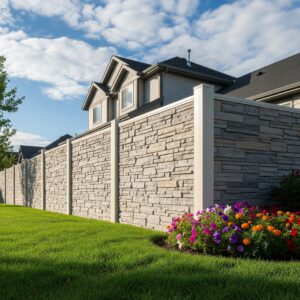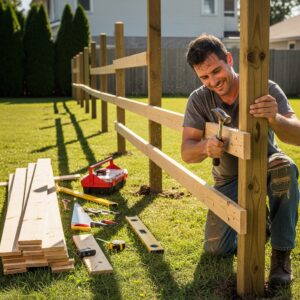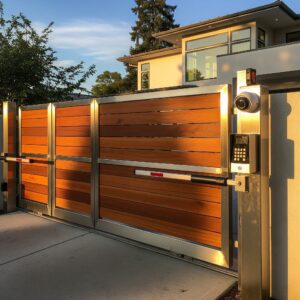Thinking About a Fence? Let’s Talk Height
If you’re planning to install a new fence, one of the first questions you’ll ask is:
“How tall should my fence be?”
The answer depends on what you want your fence to do—keep pets in, keep prying eyes out, boost curb appeal, or all of the above. Whether you’re eyeing a low decorative fence or a tall privacy or security barrier, the height plays a major role in how well your fence actually works for you.
Let’s break down the best fence height for every purpose—with real examples, easy-to-understand comparisons, and a little guidance on what’s legal and smart for your property.
Fence Height by Purpose
1. Privacy Fences
If you want to block views from neighbors or the street, you’ll want your fence to be at least 6 feet high.
-
Typical Height: 6–8 feet
-
Best Materials: Wood, vinyl, composite, or iron panels with privacy screens
-
Where It Works Best: Backyards, side yards, patios
💡 Example: If you live in a suburban neighborhood and want to relax in your backyard without worrying about the neighbor’s second-story window—go with a solid 6-foot privacy fence.
👉 Heads-up: In many cities, 6 feet is the legal max for backyard fences unless you get a permit.
2. Front Yard or Decorative Fences
Front yard fences are usually more about looks and boundaries than security or privacy.
-
Typical Height: 3–4 feet
-
Best Materials: Ornamental iron, wood picket, split rail
-
Where It Works Best: Front yards, gardens, around pathways
💡 Example: A classic white picket fence at 3.5 feet gives your front yard definition without feeling closed-off. An ornamental iron fence adds a higher-end look while still being neighbor-friendly.
👉 Note: Many municipalities limit front yard fence height to 3 or 4 feet, especially on corner lots to preserve visibility.
3. Security Fences
For deterring intruders, height is your ally. A security fence should be tall, sturdy, and hard to climb.
-
Typical Height: 6–8 feet (sometimes up to 10 ft for commercial use)
-
Best Materials: Wrought iron, steel, chain link (with privacy slats or barbed top), or masonry
-
Where It Works Best: Perimeter fences, commercial properties, gated entrances
💡 Example: A wrought iron security fence at 7 feet with spear tops provides both elegance and real protection—ideal for homes with long driveways or gated entries.
🔗 For more on material choices, check out our wrought iron vs. steel gates comparison.
4. Pool Fences
Pool fences must follow strict safety guidelines, especially if kids are around.
-
Typical Height: At least 4 feet (California requires 60 inches for child safety)
-
Best Materials: Iron, mesh, tempered glass panels
-
Where It Works Best: Surrounding backyard or in-ground pools
💡 Example: A 5-foot iron pool fence with self-latching gates meets most local codes and adds a clean, upscale look.
👉 Always check your local code for specific pool fence height and latch requirements.
5. Pet and Garden Fences
If you’re trying to keep your dog in (or deer out), your fence height matters just as much as the material.
-
For Small Dogs: 3–4 feet is plenty
-
For Large Dogs (or jumpers): Go with 5–6 feet
-
For Deer Deterrence: You’ll need at least 7–8 feet
-
Best Materials: Wire mesh, wood, iron, or vinyl
💡 Example: A 4-foot wood fence works well for a garden and keeps most small dogs inside. If your pup is an escape artist, bump it up to 6 feet.
Aesthetics Matter, Too
Sometimes it’s not about keeping things out—it’s about looking great.
Here’s a quick guide:
| Fence Style | Ideal Height | Purpose |
|---|---|---|
| Picket or Decorative | 3–4 ft | Style + boundary |
| Solid Privacy | 6–8 ft | Privacy + security |
| Iron Driveway Entry | 5–6 ft | Style + access control |
| Custom Iron Fence Panels | Varies (3–8 ft) | Style + flexible use |
Want to see custom fence designs in action? Visit IrishIron.com to explore our photo gallery and recent builds.
What’s Legal? (And What to Check Before You Build)
-
City & HOA Rules: Most cities cap backyard fences at 6 ft and front yard fences at 3–4 ft.
-
Permits: In some areas, anything over 6 feet requires a permit or inspection.
-
Neighbor Considerations: If you’re building near a property line, it’s always good to give your neighbor a heads-up—even if the law doesn’t require it.
- California Fence Law: According to California Civil Code § 841, adjoining landowners are equally responsible for maintaining boundary fences unless otherwise agreed.
Final Thoughts: Choose the Right Height for Your Needs
There’s no one-size-fits-all answer. Your perfect fence height depends on why you need a fence and what kind of property you’re fencing in.
-
For privacy? Go 6–8 feet.
-
For curb appeal? 3–4 feet is perfect.
-
For full security? Get a tall, strong material—like wrought iron—at 6–8 feet.
Whether you’re building a backyard retreat, protecting your pool, or framing the perfect entrance to your home, choosing the right height sets the tone for everything.
Need help deciding? Contact Irish Iron for a free consultation. We’ll help you design a fence that looks incredible, lasts for years, and fits your lifestyle.



